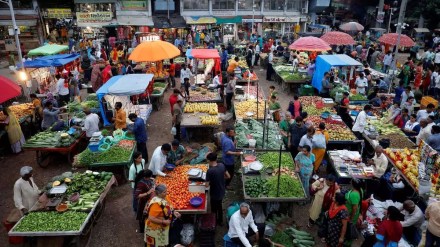The Centre’s measures, including the imposition of taxes and export restrictions, have helped in cooling the prices of rice and onions, Niti Aayog member Ramesh Chand said. The government will soon undertake a study on the productivity of labour under the Mahatma Gandhi National Rural Employment Guarantee Act as the scheme is vulnerable to leakages and questions are being raised about the quality of assets created under the scheme, Chand told FE’s Sandip Das and Prasanta Sahu. Edited excerpts:
Have measures like export duties on rice and onion given results in controlling inflation?
If the timely decision on imposing 40% import duty last month were not taken, it would have led to a crisis and spike in prices. In the case of rice and onion, we have succeeded. At present, the wholesale rice prices in Thailand and Vietnam have reached $600/tonne or more than `50/kg. In our case, the wholesale price is around `37/kg and it has never crossed `38/kg. While there are curbs on rice exports, shipments are going. We did not want excess exports to take place. Our rice exports are still expected to cross 20 million tonne this fiscal. Recently, the government approved 75,000 tonne of non-basmati rice exports to the United Arab Emirates. The overall situation on rice supplies would be assessed once grain starts arriving in the market.
What is your assessment of the government’s target of doubling farmers’ income?
I can’t say whether the farmers’ income has doubled or not but certainly, I can say that the kind of growth in income of farmers we have seen in the last seven to eight years is unprecedented. Annual cash transfer of `60,000 crore to farmers under PM Kisan has also enhanced farmers’ income. In real terms, the growth in the agriculture sector is 4% and there is an increase in terms of trade. If you add all these, we will be moving closer to the target of doubling the farmers’ income.
Is the government launching any new welfare scheme?
In the recent years lots of positive things have happened in the agriculture sector. Terms of trade in agriculture are rapidly rising, which means real prices of the agriculture sector compared to non-agriculture are rising as indicated by the recent retail food and non-food inflation. Food prices are rising at the same rate as other prices. This makes a big difference. The prices have benefited the farmers while prices of urea have not been changed since 2018. No tariff is charged on power supply to the agriculture sector. Recently, trade has become a big source of increase in farmers’ income. A few years back we used to hear about farmers suicides and, because of positive terms of trade, such incidents are rare now. In the last one decade, public procurement has increased. Earlier rice and wheat procurement was restricted to three or four states, but at present, procurement of grain is taking place in 12 states. Procurement was earlier focussed on rice and wheat, we are now procuring pulses for buffer stock and also oilseeds.
Your assessment of the rural distress due to the rise in demand for jobs under NREGA?
The demand under NREGA (Mahatma Gandhi National Rural Employment Guarantee Act) is rising because of several reasons. It’s not because people are not getting work. Over time, there is a lot of leakage in NREGA. Male members prefer normal kind of employment while women go for NREGA. NREGA employment is less taxing and productivity is also low. I do not consider the increase in work under NREGA as an indicator of distress. Reports are coming that much of the work under NREGA is done under machines. How do you do social audits? In most cases, people are looking at social audits whether workers are getting payment but they seldom look at the productivity of the assets created. We will undertake a study on the productivity of labour under NREGA.
What is your assessment of agriculture growth for the current fiscal?
I think we will end this fiscal year with between 3.25 to 3.4% growth. It’s not only crops, which are growing… livestock sector is also growing. We are taking the initiative to harness the growth potential of the fisheries sector and holding workshops. This growth in fisheries of 10% without government subsidy is encouraging.
What is your view on the apprehensions about the robustness of the output of agricultural crop data provided by the government?
Until recently, the area and yield estimate of crops used to be compiled on the basis of reports from the states. There was no independent mechanism available to the Centre to find out whether the data provided by states is adequate or not. Currently, three methods are used for preparing area estimates for some of the crops. Besides the report from the states, Mahalanobis National Crop Forecast Center, under the agriculture ministry, provides their own estimates after looking at some vegetation and this mechanism is quite robust in case of rice and wheat. The technology for other crops is being standardised. Then several research institutes forecast output using space, agro-meteorology and land based observations (Fasal) which looks into past prices, fertiliser uptake then they undertake economic exercise to provide estimates. Error relating to crops areas have been minimised. In case of yield, we are yet to standardise the Normalized Difference Vegetation Index which few countries have adopted to project the yield. As sowing season progresses, we put some variables to estimate production. Besides there are several crops especially rabi crops which are sensitive to climate change. Thus, yield projection is a difficult exercise,
